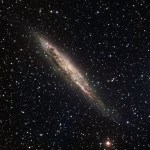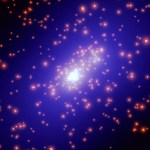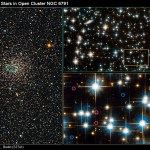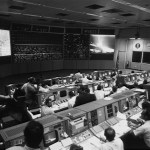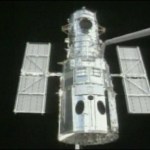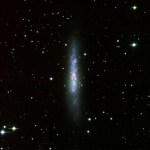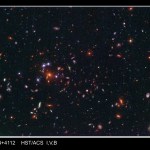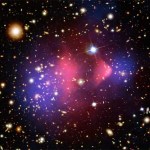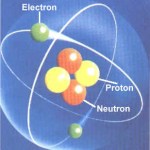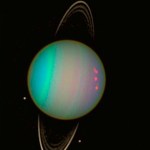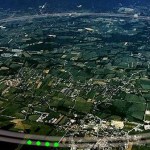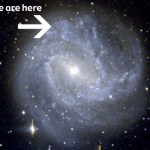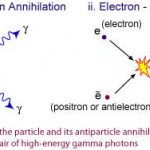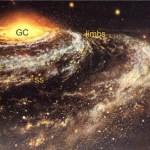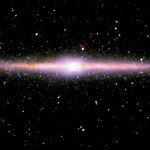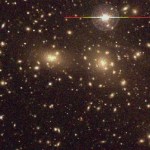Dark Matter
Deep into the darkness peering,
long I stood there, wondering, fearing,
Doubting, dreaming dreams no mortal ever dared to dream before.
-Edgar Allen Poe, The Raven
Gazing out into the dark abyss of the night sky, stars, galaxies, and clusters shine like tiny islands of light against the blackness of deep space. Trillions upon trillions of protons and neutrons fuse together in stars across the Universe, producing all of this light, and decorating the sky above.
But, as we learned in part one of this series, the starlight that we see only accounts for 2% of all the matter that gravity tells us…
Long you live and high you fly
Smiles you'll give and tears you'll cry
All you touch and all you see
Is all your life will ever be. -Pink Floyd
In part I of this series, we talked about a number of different ways -- all using gravity -- to measure the amount of matter in galaxies, clusters of galaxies, and the entire Universe. We got the same measurement no matter which method we used, finding out that 25-30% of the total energy of the Universe is in some type of matter. But, only about 0.5% of the total energy is in stars, which means that nearly all of this matter doesn't give off light! So…
There are two ways to slide easily through life; to believe everything or to doubt everything. Both ways save us from thinking. -Alfred Korzybski
I've recently received a number of messages from readers of this site expressing doubts about the existence of dark matter. As someone who's researched dark matter extensively, it is my determination that dark matter most likely exists, although explaining exactly what it is is a challenge. Over this next series, I would like to lead you through the evidence, observations and discoveries that have led me to this conclusion, and I hope that I explain…
The last 100 years have brought us from a Universe no bigger than the Milky Way ruled by Newton's gravity to a vast, expanding one with hundreds of billions of galaxies, covered in dark matter, beginning with the big bang, which was likely caused by inflation, and which will end in a freezing cold death as the galaxies accelerate away from one another, off into infinity. We gained and confirmed a new theory of gravity; we learned how all the elements in the Universe were made. We detected neutrinos from an exploding star hundreds of thousands of light years away. And we walked on the Moon.…
There are many great discoveries that happened in the 1930s that changed our view of the Universe. From tiny discoveries (the neutron) to huge ones (Pluto), from theoretical explanations of antimatter to the neutrino to the start of quantum field theory, the 1930s were a great time for making new discoveries. But one man often gets left out of these discussions, IMO, because he was too far ahead of his time.
Meet Fritz Zwicky. Born in Bulgaria, a citizen of Switzerland, and did his best work at Caltech. (In fact, his daughter Barberina has noticed my old site!) Fritz was in the very tough…
Yesterday, the Space Shuttle Atlantis docked with the Hubble Space Telescope, and now the removal and replacement of WFPC2 has commenced.
As you probably know, I'm going to miss that camera. It's been unveiling the secrets of the Universe for the last 16 years, and in a way that no other camera ever has before. So, you can check out parts one, two, and three in my series of ways that this camera has changed the Universe, and then look below for today's edition of saying goodbye to Hubble's grand old camera, WFPC2.
Part FourOnce in awhile, we get very lucky in the Universe. Instead of looking…
The Universe is full of stuff; both normal matter and dark matter are practically everywhere we look. But the Universe looks as interesting as it does because of what gravity does to it. It takes a Universe that starts out with almost the same exact temperature and density everywhere (the initial differences are one part in about 30,000) and turns it into a web of matter littered with galaxies and clusters of galaxies at the densest places.
But one of the neatest things about this is that the Universe continues to evolve. We know how stars work, and we can tell when galaxies are forming…
It seems like it was just last week that I wrote about colliding dark matter, showing what happens when two galaxy clusters collide.
Well, nature has gone and one-upped me. Let me explain. Galaxy clusters are huge conglomerations of matter: normal matter (protons, neutrons, electrons, etc.) and dark matter (this mysterious, non-collisional stuff). We find them all over the place, and they can contain anywhere from a handful to thousands of galaxies. They are spectacular sights, and I'll give you one below.
But one thing these galaxy clusters do, even today, is continue to gravitationally…
I want to thank everyone for their great interest in my last post on dark matter! I got an awful lot of questions about what I mean by dark matter being "collisionless," and in particular, about this picture:
This is two galaxy clusters that have collided recently. The pink shows the X-ray emissions, which comes from the normal matter in the clusters colliding and heating up. The blue shows the mass, and where it is, which I contend needs to be mostly dark matter.
Well, many of you are skeptical, and rightfully so. So I've decided to set you straight, by showing you a visual simulation (that…
Over the last few decades, we've learned a lot of interesting things about the Universe. One of the most groundbreaking is that most of the matter in the Universe is not made up of all the stuff we know as normal matter: protons, neutrons, and electrons.
This means that atoms, the basic building block of all we know and love on Earth, make up only a small fraction of the mass in the Universe.
How do we know this? Well, there are lots of reasons, but they all boil down to these two things: we use telescopes to measure light, which tells us about the amount of normal matter in the Universe,…
(This is adapted from my public lecture, Afraid of the Dark: How We Know What We Can't See.)
Let's go back over 200 years ago, to 1781. William Herschel (left) discovered the planet Uranus, noticing that an object, as bright as a star, was actually moving relative to the other stars. The other five inner planets (besides Earth) were known for over 2000 years before that. But it was thought for a long time that Saturn was the farthest one.
But it clearly isn't; as you can see with modern telescopes, Uranus is a super-interesting planet, rotating on its side, surrounded by rings and moons.…
Hector writes in and asks about someone from Sheffield in the UK who says that the Large Hadron Collider (LHC) will create Dark Matter:
The massive ATLAS detector will measure the debris from collisions occurring in the Large Hadron Collider (LHC) which recreates the conditions found in the early universe during the Big Bang when Dark Matter was first created. If the LHC does indeed create such particles then it will be the first time that the amount of Dark Matter in the universe has increased since the Big Bang - the LHC will effectively be a Dark Matter 'factory'.
Well, Hector basically…
Can you believe that I had a fight today with someone who's been dead for over 350 years, and I'm losing? -- Ethan, yesterday
Of course you can believe it, when the man I'm fighting with is Johannes Kepler. I don't get a chance to tell you about my research very often, mostly because it's still a work in progress. But my latest paper was just submitted and is now out of the way, and so I'd like to tell you what I'm working on at the moment.
Well, there we are in the galaxy. We look up at the night sky, and we see our planets as well as all the stars that surround us. But you know what we don…
Remember how I told you earlier this week that DAMA was going to announce that they found dark matter, even though the signal that they found is not consistent with other experiments?
Looks like my powers of predicting the future are pretty damned good. They have a new plot with more data showing the continued modulation at a certain energy range:
and also one showing the fact that they see a bunch of extra events happening in that energy range:
So here's the stuff that DAMA has seen: a nuclear recoil that has many events in a certain energy range, and has a 2% annual modulation in that…
Yesterday, my good friend (and SWAB reader) Brian wrote a great comment about the practical reasons to explore space, where he talked about the overall economic impact that Space Exploration has had on the economy, as well as the impact it has had on our knowledge and understanding of the Earth, its environment, and how to manage/mitigate the threats to it. And that's wonderful for exploring our Solar System and others.
But what do I do in the meantime? After all, this isn't what I study or explore. So I asked this:
The practical arguments as to why exploration of space is worthwhile…
The DAMA collaboration, an experimental team searching for dark matter via direct detection, is poised to report this week that they have discovered Dark Matter. And I'm here to pre-empt that by bringing you the truth: no, they haven't.
They take some very cold (cryogenic) atoms,
look for nuclear recoils resulting from dark matter collisions, subtract the background, and draw conclusions based on whatever's left over. Their expectations are based on the following:
Neutrons, neutrinos, and other standard model particles from the Earth, the Sun, and the Milky Way galaxy will collide with the…
So last week I was up at Pacific University in Portland, OR for a job interview. As part of a faculty interview, you have to lecture on a topic for undergraduates, but they give you the topic just a couple of days before. My topic was Gauss' Law, which talks about the relationship between an Electric Field and an Electric Charge. Well, the same law holds for Newton's theory of Gravitation with a gravitational field instead of an electric field and a gravitational charge (i.e., mass) instead of an electric charge.
So I'm at work today thinking about this, doing the thing I do messing around…
So I gave a public lecture last (Monday) night called, "Afraid of the Dark: How We Know What We Can't See" and videotaped it. Now, I'm pretty good at what I'm doing right now (research in theoretical cosmology), but I'm really good at public speaking and teaching, and here is me telling a public audience all about dark matter, how we know it exists, what makes it different from normal matter, and what I'm trying to do to find it/discover its nature for a good 40 minutes. (The intro and question/answers are cut out).
It was a lot of fun; the audience was wonderful, and actually kept me for…
Alright, startswithabang-ers, Ben, my most avid commenter, saw me online while I was eating breakfast this morning, and pointed me to this new press release. Now, before you get started clicking on everything, the guy who the release is about is Brian Gaensler, who's a really nice guy, lives in Australia, whom I met at the AAS (American Astronomical Society) meeting in Austin, TX last month. Bryan's also brilliant.
Basically, what he did was he said, "well, we know what the rough density of hot gas in our galaxy is, and we can measure the timing of these pulsars to extraordinary accuracy."…
Last week, Pamela Gay over at Star Stryder pointed me to a press release which claimed that, among other things, perhaps dark matter wasn't necessary. So I wrote a guest post on her blog explaining why it was. Apparently, some people still aren't convinced. So I will lay out for you all the reasons I can think of why we need it, and explain what happens if you try to do without it.
1. Cluster Velocity Dispersions. When we take a look at galaxies, we often find hundreds or even thousands of them clustered together, like in the Coma Cluster. We can measure how quickly those galaxies are moving…
